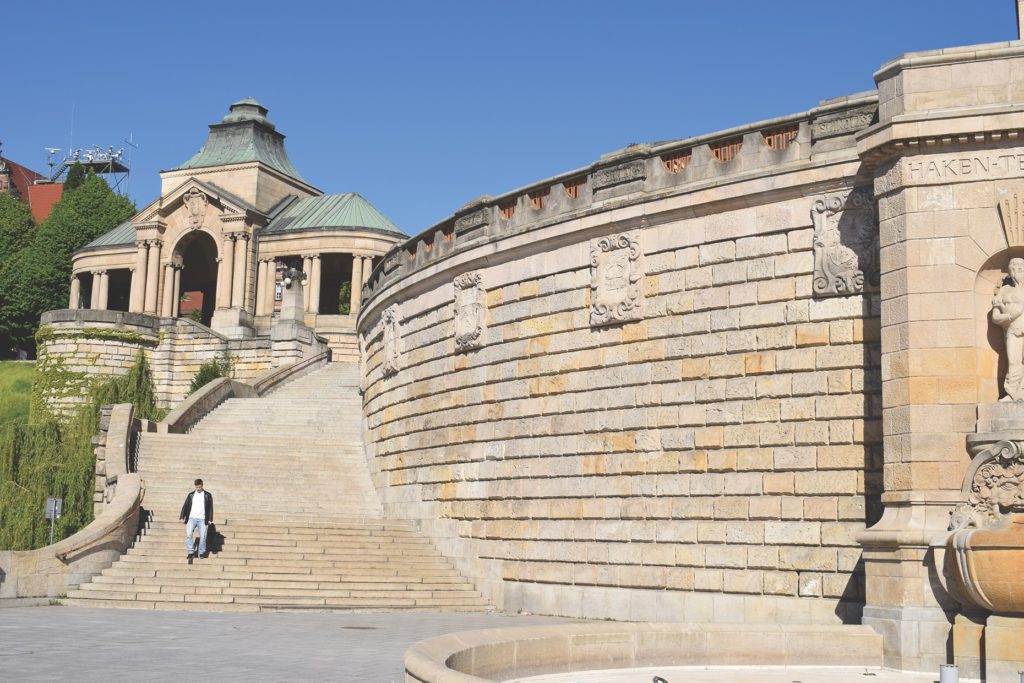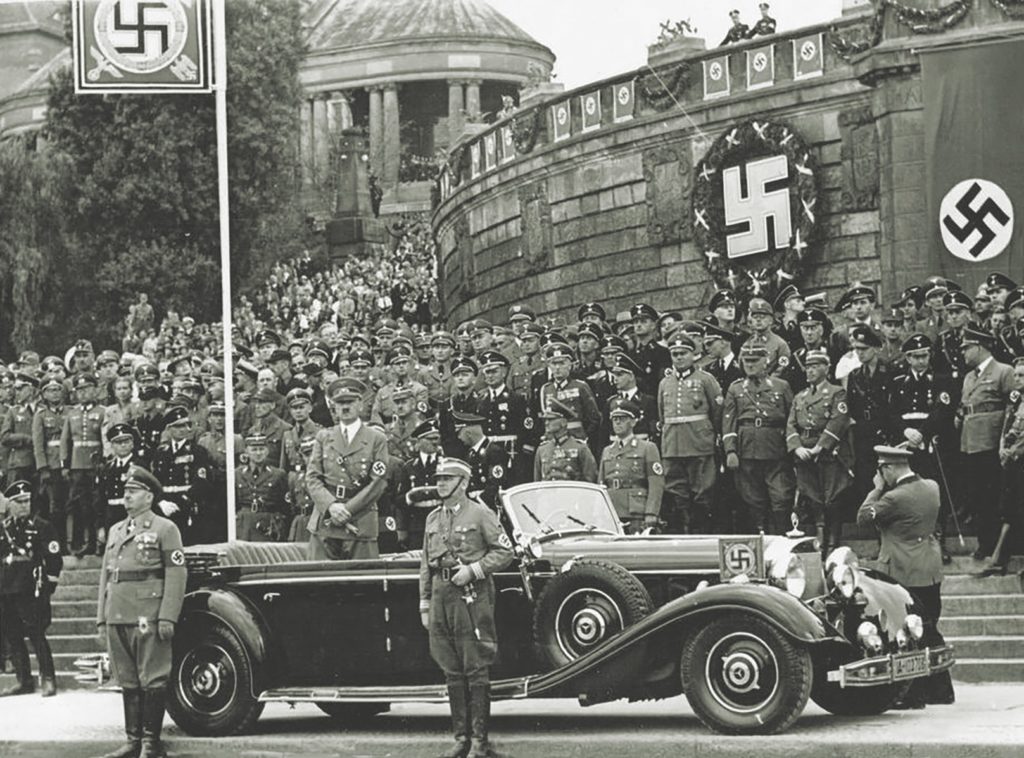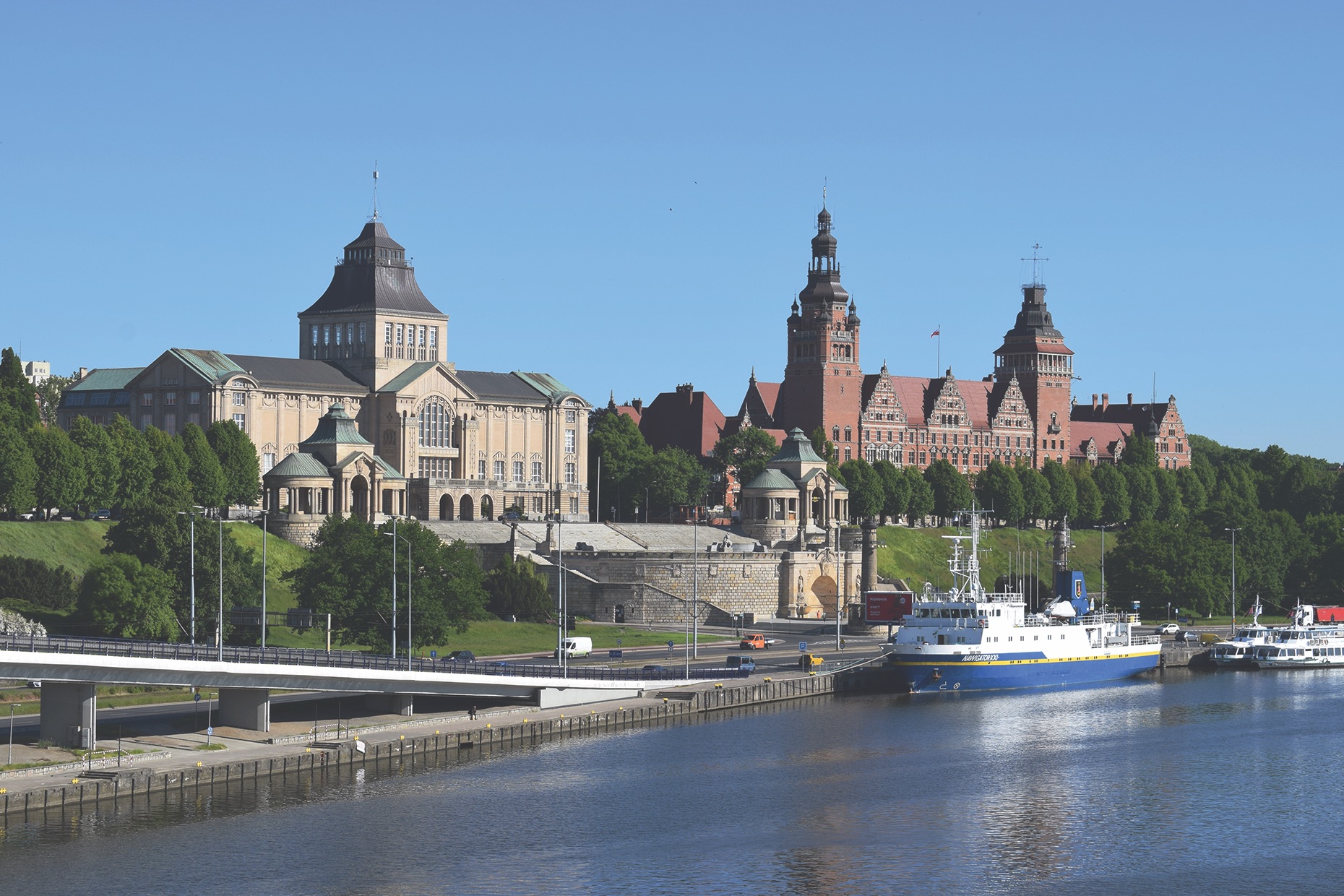In June 1938, Adolf Hitler paid a visit to the then-German city, a stronghold of the Nazi movement.
THE FIRST TIME I RECALL hearing about Stettin, or Szczecin as it is called in Polish, was in the famous speech Winston Churchill gave at Westminster College in Fulton, Missouri, in March 1946, when he sounded an early alarm in the Cold War. “From Stettin in the Baltic to Trieste in the Adriatic, an ‘iron curtain’ has descended across the continent,” declared the former British prime minister. My mind’s-eye view of Stettin became even grimmer when I learned that much of the city had been reduced to ashes in World War II.
So imagine my surprise, 75 years after Churchill’s address, when I discover how stunning parts of this riverport in northwest Poland are today. Its handsome old Paris Quarter, laid out by German architect James Hobrecht in the 1880s according to a French blueprint, is replete with beautiful fin-de-siècle apartment buildings. The new Philharmonic concert hall is a glowing marvel of modern architecture. But the real showpiece is a raised, tree-lined escarpment known as Wały Chrobrego (Chrobry Embankment), home to a striking ensemble of historic structures overlooking the Oder River. Nearly a third of a mile long, this gem, along with the Paris Quarter, amazingly escaped serious damage during the war, which obliterated 60 percent of the city’s buildings and 95 percent of its Old Town.


Few places evoke the city’s National Socialist past more than the observation platform on the embankment, where Adolf Hitler addressed the masses during a carefully choreographed visit on June 12, 1938, when Szczecin was still the German city of Stettin. I discover there are enough surviving roads and buildings from the era to reconstruct much of Hitler’s route through town, which can be experienced on an easy 90-minute walk.
Planned months in advance, the Führer’s visit was reported in an extremely lively manner by the Pommersche Zeitung, then a propaganda organ of the German province of Pomerania’s Nazi Party. The newspaper assumed a messianic tone, emphasizing the inhabitants’ joy at the arrival of their awaited “savior.” Photos from the day give an idea of the enormous crowds, with people waving at the dictator from apartment windows, streetlamps, and even the roofs of houses. On the big day, an estimated 100,000 spectators swelled the streets of Stettin, all eager to get a glimpse of the Führer.
The capital city of Pomerania, Stettin was a stronghold of the Nazi movement and crucial to Germany’s political and economic aspirations, according to Wojciech Wichert, a historian at Poland’s Institute of National Remembrance. Much of Hitler’s local support stemmed from new investment and job creation programs he introduced after 1933, including several public housing developments, a gigantic grain elevator, and a brand-new autobahn to Berlin—all still in use today—plus Nazi cash infusions to key industries such as shipbuilding and, increasingly, armaments. During World War II, Stettin was the base for the German 2nd Motorized Infantry Division, which helped lead the invasion of Poland in 1939 and acted as a launch point for Operation Weserübung, Germany’s attack on Denmark and Norway.
All German street signs here were recast in Polish once Germany ceded the region after the war, so I keep a list of both versions as I begin retracing Hitler’s movements from Stettin’s main railway station. The dictator’s private train from Berlin arrived precisely at 1:30 p.m., at which time he was greeted by top Nazi brass including his deputy, Rudolf Hess, and SS chief Heinrich Himmler. Based on historical photos of the event, I can make out the exact spot in the station where the Führer reviewed military formations against a backdrop of festively decorated ships on the Oder, which were part of the welcoming ceremony. Then Hitler and the Gauleiter—the Nazi local district leader—took their places in a government Mercedes, where the dictator would remain standing while giving ecstatic crowds the Nazi salute.
During my visit to the station, I stop by the Szczecin Underground Routes museum. This extensive tunnel network, opened in 1941, remains the biggest civic air-raid shelter in Poland, built to accommodate 5,000 people. It’s chilly down here, and I wonder how the masses must have felt during a wartime bombing raid after such unbridled optimism only a few years earlier. “The Germans converted underground corridors from the 18th century,” explains Agnieszka Fader, a group tour guide at the facility, referring to fortifications built by King Frederick William I of Prussia. Original signage in German is still visible on the walls, such as “Ruhe bewahren” (Stay calm). The bunker had innovative features such as special washrooms for mothers with children, cork linings to muffle footfalls on the steps and floors, and red floors to mask any bloodstains in order to prevent panic spreading among the thousands in the shelter.
From the rail terminal, Hitler’s entourage drove northwest through Grüne Schanze—today’s Dworcowa Street—passing the gorgeous redbrick Old City Hall from the 19th century along the way—then north through busy Paradeplatz (now Niepodległości) thoroughfare and up the grand avenue Kaiser-Wilhelm-Strasse (now Papieża Jana Pawła II) to arrive at the spinach-green Landeshaus, then seat of the Pomeranian provincial government and the present-day city hall. Like other landmark buildings, the Landeshaus was festooned with Nazi regalia back in 1938, an image I find particularly chilling when compared with today’s edifice, which, minus the swastika banners, appears little changed.
After another ritual review of military formations, the Führer addressed a Nazi Party congress and met with Stettin’s mayor, Werner Faber, who presented him with an honorary citizenship of the city. Oddly, the present city council says it cannot strip Hitler of this distinction because it was awarded by the previous (German) administration and current Polish laws do not provide them a means to address the issue—a controversial matter that, from time to time, draws fierce protests among the locals.
According to Hitler’s schedule, he left the Landeshaus at exactly 2:27 p.m. to visit the City Museum—today’s imposing National Museum—on Wały Chrobrego, which was then called Hakenterrasse. The culmination of his visit came at 3 p.m.: an address by Hitler to the huge crowd followed by a grand parade of nearly 47,000 members of party organizations including the SS, SA, and Hitler Youth. The Nazi leader surveyed the proceedings from the embankment’s observation platform before descending to his open limousine at the foot of Hakenterrasse. I’m able to find the exact location of Hitler’s car as I gaze over the former steamboat dock, where a throng of onlookers fed the Führer’s insatiable cult of personality.
The many Nazi officials Hitler saw that day likely included the governors of a synthetic fuel manufacturing plant in Police, a one-time Stettin suburb. The Hydrierwerke Pölitz (Hydrogenation Plant Police) converted powdered lignite coal into liquid fuels, including high-grade gasoline. Opened in 1937, the facility was built to boost the war effort, producing as much as 15 percent of Germany’s fuel needs at its peak. The plant also acted as a satellite camp for the Stutthof, Sachsenhausen, and Ravensbrück concentration camps, whose prisoners made up the bulk of the plant’s workforce. About 30,000 laborers, mostly Poles, were forced to work there from 1939 to 1945; around 13,000 died. From May 1944, the plant became the target of frequent Allied air raids. After the war, the site fell into disrepair, hastened by the Red Army’s removal of any useful materials, which it sent to the Soviet Union. My personal highlight is the evil-looking synthetic gasoline factory, with vertical slits like gills in its roof cladding. I manage to navigate this vast site despite precious little signage, exercising care among the rickety concrete ruins being reclaimed by nature, before peeking into the plant’s small museum of history, weaponry, and items found here.

When the waterfront parade in Stettin ended, the Führer took a half-hour motorboat cruise on the Oder in the company of the mayor and Franz Schwede-Coburg, president of Pomeranian Province, to see the port area and the former Vulcan company shipyard, which was reopened at Hitler’s request in 1939. Finally, shortly after 6 p.m., Hitler bid his beloved followers goodbye from the window of his private train carriage and sped back to Berlin.
It would be the Führer’s final visit to Stettin before it was handed over to Polish authorities in July 1945 in a de facto recognition of Poland’s postwar border with Germany. Most of that frontier would be confirmed at the Allies’ Potsdam Conference later that summer. In September 1945, the Polish-Soviet Schwerin border treaty sealed the remaining bit of border near the Baltic Sea—allowing German Stettin to become Polish Szczecin. With roots in both Poland and Germany, I find it fascinating to compare the city’s dual history and marvel at its remarkable ascent from the ashes of war. ✯
WHEN YOU GO
May through September is the best time to visit Szczecin. The city has a small airport, Goleniów, but many visitors fly into Berlin and take a two-hour train ride. The entrance for the Szczecin Underground Routes museum is just behind the rail terminal on Platform 1. To reach the factory ruins in Police, take bus no. 107 from Szczecin’s Plac Rodla, change to bus no. 102, and get off at Tanowska Szkoła 11 (one hour).
Where to Stay and Eat
Great deals for lodging abound in Szczecin, starting at around $40 a night for apartments through Airbnb. The leafy, historic Park Hotel boasts a celebrated restaurant, while the Radisson Blu offers dreamy views over the Oder. Traditional Polish specialties such as stuffed pierogi with sauerkraut or roast duck can be sampled at rustic Karczma Polska.
What Else to See and Do
Szczecin is a paradise for watersports. Across the Oder from Wały Chrobrego, you can rent motorboats to explore the commercial harbor and the charming old waterfront district. The redeveloped port area at Łasztownia, lorded over by neon-lit antique cranes, makes a pleasant way to view the amazing architecture on the Oder’s west bank. Dotted with bars and cafes, the pedestrian boulevard here teems with merrymakers on balmy evenings. ✯
This article was published in the October 2021 issue of World War II.





